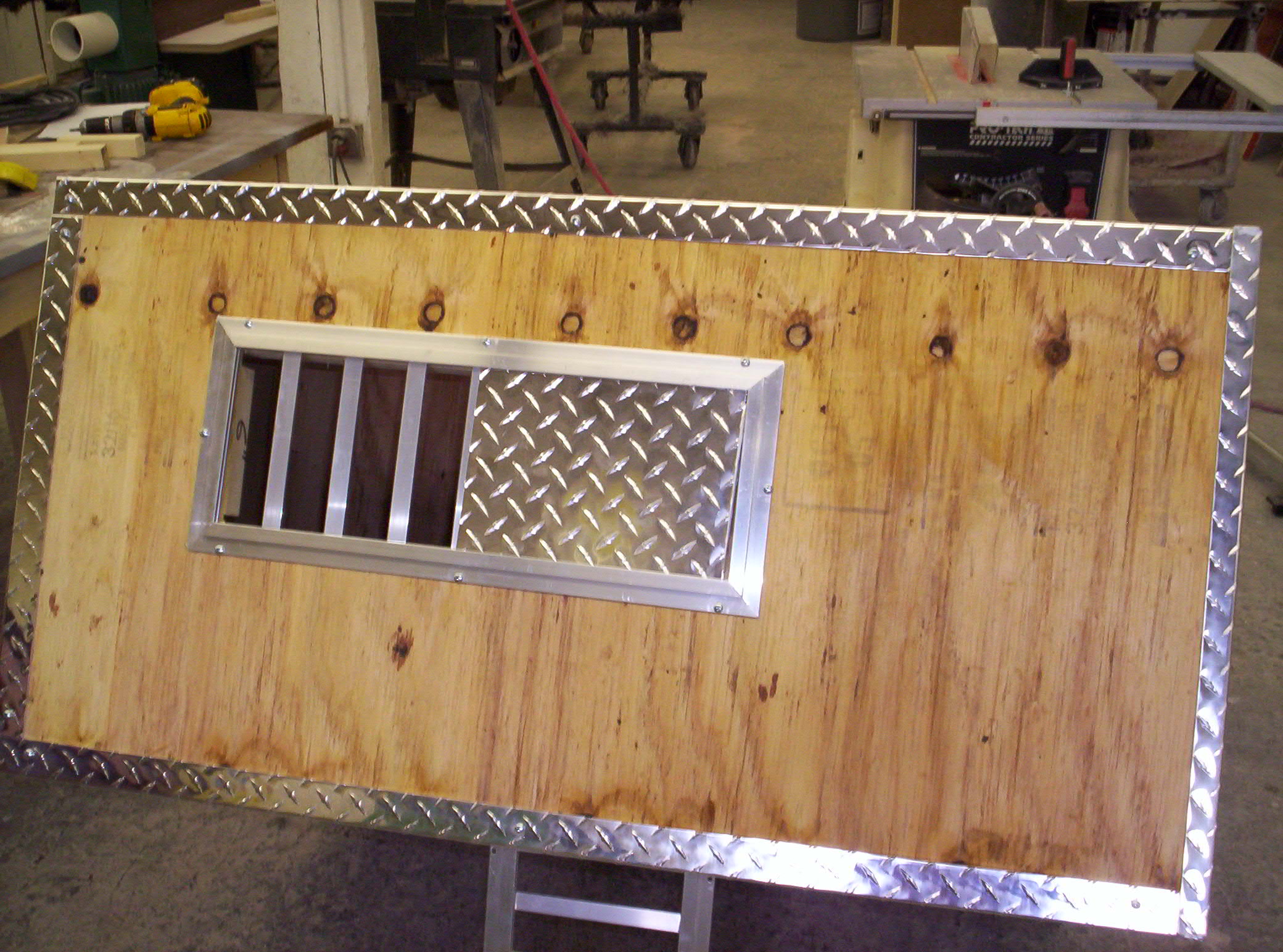How to Build a Dog Box for a Truck? To build a dog box for a truck, gather materials like wood, screws, and hinges. Measure your truck bed, then construct a sturdy, ventilated box that fits securely.
Creating a dog box for your truck is essential for safe travel with your furry companion. A well-built dog box protects your pet from harsh weather and offers a comfortable space during long trips. Proper ventilation and secure fastening are crucial for your dog’s safety.
With the right materials and measurements, you can design a custom dog box that suits your needs. This project not only enhances your pet’s travel experience but also ensures peace of mind while on the road. Let’s explore the steps to create a durable and functional dog box for your vehicle.
Table of Contents
Introduction To Dog Boxes
Dog boxes are essential for transporting your furry friends safely. They provide a secure space in your truck for your dog during travel. Understanding their purpose and benefits is key to choosing the right box.
The Purpose Of A Dog Box
The primary purpose of a dog box is to ensure your pet’s safety. Here are some key functions:
- Protection: Shields dogs from wind, rain, and sun.
- Security: Keeps dogs contained and prevents jumping out.
- Comfort: Offers a cozy space for your dog to rest.
- Organization: Helps keep your truck clean and tidy.
Benefits Of A Custom Dog Box
A custom dog box offers various advantages over standard options. Consider these benefits:
| Benefit | Description |
|---|---|
| Perfect Fit | Designed to fit your truck’s specific measurements. |
| Durability | Made from high-quality materials to withstand wear. |
| Personalization | Customize features like color, size, and compartments. |
| Enhanced Safety | Built-in safety features protect your dog during travel. |
Investing in a custom dog box improves your pet’s travel experience. It ensures safety and comfort on every adventure.

Credit: www.owens-pro.com
Assessing Your Needs
Building a dog box for your truck requires careful planning. Understanding your needs is the first step. This ensures your dog stays safe and comfortable during travels.
Determining The Right Size
Choosing the right size for your dog box is crucial. Consider the following:
- Dog Breed: Larger breeds need more space.
- Dog Age: Puppies might need extra room to grow.
- Activity Level: Active dogs may require more space to move.
Measure your dog from nose to tail and from the ground to the top of their head. Use these dimensions to find a suitable box size.
Here’s a quick size guide:
| Dog Size | Box Dimensions (L x W x H) |
|---|---|
| Small (up to 25 lbs) | 24″ x 18″ x 18″ |
| Medium (26-50 lbs) | 36″ x 24″ x 24″ |
| Large (51-80 lbs) | 42″ x 30″ x 30″ |
| X-Large (81 lbs and up) | 48″ x 36″ x 36″ |
Considering Your Dog’s Comfort
Your dog’s comfort is key for a happy trip. Keep these factors in mind:
- Ventilation: Ensure proper airflow to keep your dog cool.
- Padding: Use soft materials for a cozy space.
- Shade: Consider a box that provides shade from the sun.
Adding a non-slip mat can help your dog feel secure. Make sure the box is easy for them to enter and exit. A comfortable dog is a happy travel companion.
Designing Your Dog Box
Designing your dog box is crucial. A well-designed box ensures your dog’s safety and comfort. Follow these steps to create the perfect design.
Choosing Materials
Choosing the right materials is vital. The materials must be durable and safe. Here are some common materials:
- Wood: Strong and easy to work with.
- Metal: Very durable and secure.
- Plastic: Lightweight and weather-resistant.
Consider these factors:
| Material | Pros | Cons |
|---|---|---|
| Wood | Easy to cut and shape. | Can rot if not treated. |
| Metal | Highly secure and long-lasting. | Can be heavy and expensive. |
| Plastic | Lightweight and easy to clean. | May not be as strong as wood or metal. |
Blueprints And Planning
Creating blueprints helps visualize the dog box. Start by measuring the space in your truck. Follow these steps to create effective blueprints:
- Measure your dog’s size.
- Decide on the box dimensions.
- Sketch a layout on paper.
- Consider ventilation and access points.
Include the following in your plans:
- Ventilation: Ensure proper airflow.
- Access: Easy entry and exit for your dog.
- Safety: Smooth edges and secure latches.
Take your time with planning. A solid plan leads to a successful build.
Gathering Your Tools And Materials
Building a dog box for your truck requires careful planning. Start by gathering essential tools and quality materials. This ensures a sturdy and safe space for your dog.
Essential Tools For The Build
- Measuring Tape: For accurate dimensions.
- Saw: A circular or jigsaw works best.
- Drill: For making holes and driving screws.
- Screwdriver: Essential for assembly.
- Sandpaper: To smooth rough edges.
- Paintbrush: For applying sealant or paint.
- Safety Gear: Goggles and gloves for protection.
Selecting Quality Materials
Choosing the right materials is crucial for durability. Here are some recommended materials:
| Material | Purpose | Benefits |
|---|---|---|
| Plywood | Walls and base | Strong and weather-resistant |
| Wood Screws | Assembly | Provides solid connections |
| Sealant | Waterproofing | Protects against moisture damage |
| Non-toxic Paint | Finishing | Safe for your pet |
Always choose materials that suit your dog’s size and needs. Quality materials ensure safety and longevity for the dog box.
Building The Frame
Building a solid frame is essential for a sturdy dog box. A well-constructed frame supports the entire structure. It also ensures safety for your pet during travel. Follow these steps to create a strong frame.
Cutting The Pieces
Start by cutting the wood pieces to the correct sizes. Use high-quality wood for durability. Here is a list of the pieces you need:
- Two pieces for the base (48” x 24”)
- Two pieces for the sides (48” x 24”)
- Two pieces for the front and back (24” x 24”)
- One piece for the roof (48” x 24”)
Use a saw to cut these pieces. Ensure all cuts are straight. Sand the edges to remove any splinters. This helps prevent injuries.
Assembling The Base Structure
Now, it’s time to assemble the base structure. Follow these steps:
- Lay the two base pieces parallel to each other.
- Attach the side pieces to the base using screws.
- Use wood glue for extra strength.
- Make sure everything is square and level.
Check the stability of the base. It should not wobble. Next, attach the front and back pieces. Use the same method with screws and glue.
Finally, secure the roof piece. This completes the basic frame. Make sure everything is tightly fastened. Your dog box frame is now ready for the next steps!
Adding Walls And A Door
Building a sturdy dog box requires strong walls and a reliable door. These elements protect your dog during travel. They also provide comfort and safety. Follow these steps to create effective walls and an entry point.
Constructing The Side Panels
Side panels form the structure of your dog box. Use durable materials like plywood or metal. Follow these steps to construct the side panels:
- Measure the height and width for your dog box.
- Cut two pieces of plywood to size.
- Sand the edges to avoid splinters.
- Attach the panels using screws or nails.
For extra strength, use corner brackets. This ensures stability. Paint or seal the wood to protect against weather.
Installing The Entry Point
The entry point allows your dog to enter and exit. It should be easy to open yet secure. Follow these steps for installation:
- Cut a door opening on one side panel.
- Measure the size based on your dog’s breed.
- Create a door from the same material.
- Attach hinges to one side of the door.
- Install a latch to keep the door secure.
Ensure the door swings smoothly. Test it multiple times. This guarantees ease of use for your dog.
Ensuring Ventilation And Insulation
Proper ventilation and insulation are vital for your dog box. They keep your pet comfortable and safe during travel. A well-ventilated and insulated dog box prevents overheating and provides a cozy space.
Creating Ventilation Openings
Ventilation is essential for your dog’s well-being. Follow these steps to create ventilation openings:
- Choose the right locations. Place openings on opposite sides.
- Use mesh screens. They keep bugs out while allowing airflow.
- Consider size. Each opening should be at least 4 inches in diameter.
Use these materials for openings:
| Material | Benefits |
|---|---|
| Wire Mesh | Durable and allows maximum airflow. |
| Plastic Grills | Lightweight and easy to clean. |
| Wooden Slats | Provides a rustic look and good airflow. |
Options For Insulating The Dog Box
Insulation helps maintain a comfortable temperature. Here are some effective insulation options:
- Foam Board: Lightweight and easy to install.
- Reflective Insulation: Reflects heat away from the box.
- Fiberglass Insulation: Provides excellent thermal resistance.
Follow these tips for proper insulation:
- Seal gaps with weather stripping.
- Use insulated panels on all sides.
- Test the temperature inside the box.
Check insulation regularly. Ensure it remains effective and intact. Keep your dog cozy and safe during every trip.
Finishing Touches
After building your dog box, focus on the final details. These finishing touches enhance comfort and durability. Let’s explore two important aspects: waterproofing and adding comfort features.
Waterproofing And Sealing
Waterproofing protects your dog box from rain and spills. Use the following materials to seal your box:
- Marine-grade plywood: Resists moisture and rot.
- Sealant: Apply a high-quality sealant to all joints.
- Waterproof paint: Use it on the exterior for extra protection.
Steps for waterproofing:
- Sand all surfaces of the box.
- Apply a coat of sealant on joints.
- Let it dry completely.
- Paint the exterior with waterproof paint.
Check for any gaps after sealing. Proper waterproofing keeps your dog dry and comfortable.
Adding Comfort Features
Comfort features make the dog box cozy. Here are some ideas:
- Soft bedding: Use durable, washable dog beds.
- Ventilation: Add vents for airflow.
- Non-slip floor: Install a rubber mat for safety.
Consider these additional options:
| Feature | Benefit |
|---|---|
| Insulation | Keeps your dog warm in winter. |
| Cooling fans | Helps in hot weather. |
| Storage compartments | Store dog supplies easily. |
Always prioritize your dog’s comfort and safety. These finishing touches make a big difference.
Safety Considerations
Building a dog box for your truck requires careful attention to safety. Your dog’s safety during travel is crucial. A secure, well-constructed dog box protects your pet from harm. It also ensures a safe ride for everyone in the vehicle.
Securing The Dog Box In The Truck
Properly securing the dog box is essential. A loose box can shift during a drive. This may cause injuries to your dog or damage to the truck.
- Use strong tie-down straps.
- Attach the box to the truck bed.
- Check for movement before every trip.
Consider the following points:
| Method | Description |
|---|---|
| Anchor Points | Install anchor points in the truck bed. |
| Non-Slip Base | Use a non-slip material under the box. |
| Weight Distribution | Ensure even weight distribution in the truck. |
Regular Maintenance Checks
Regular maintenance keeps the dog box safe and functional. Inspect for wear and tear often. Address any issues immediately.
- Check for rust or corrosion.
- Inspect straps and anchors.
- Ensure the box is clean and dry.
Follow this simple checklist:
- Inspect the exterior for damage.
- Check the hinges and locks.
- Test the stability of the box.
- Clean the interior regularly.
Safety is a priority. A well-maintained dog box keeps your pet secure during travels.

Credit: www.youtube.com

Credit: www.owens-pro.com
Frequently Asked Questions
How Do I Choose The Right Materials For A Dog Box?
Selecting materials is crucial for durability and safety. Use weather-resistant wood like plywood or treated lumber. Ensure the materials are non-toxic and safe for pets. You might also consider using metal for added strength. Always prioritize quality to withstand different weather conditions.
What Size Should A Dog Box Be For My Truck?
The size of the dog box should match your dog’s dimensions. Measure your dog’s length and height to ensure comfort. A good rule is to add a few inches to each measurement. This provides enough space for movement and lying down.
Always prioritize your dog’s comfort and safety.
How Can I Ventilate A Dog Box Properly?
Proper ventilation is essential to keep your dog comfortable. Incorporate air holes or mesh panels on the sides. This allows for airflow while keeping the box secure. Make sure the ventilation openings are positioned high to prevent rain from entering.
Always check for drafts that might chill your pet.
Is It Safe To Leave My Dog In A Box?
Leaving your dog in a box for short periods can be safe. However, ensure it’s well-ventilated and comfortable. Always provide water and avoid extreme temperatures. Regular breaks and exercise are essential for your dog’s well-being. Monitor your dog’s behavior for signs of stress.
Conclusion
Building a dog box for your truck enhances safety and comfort for your furry friend. Follow the steps outlined, and customize your design to meet your needs. A well-constructed dog box ensures your pet travels securely on all adventures. Enjoy the journey together with your loyal companion by your side.



